…the nine essays are a fitting tribute to the inventive beauty of Gandhiji and its wide-ranging applicability in present-day society…

As India celebrated the sesquicentennial of MK Gandhi last year, Marg had come out with a special issue on the lesser-known aspects of Gandhi’s engagement with aesthetics.
Gandhiji’s aesthetics was two-fold: one, it was a quest for exquisiteness and two; it was a set of principles fundamental to the personal practice. Edited by Tridip Suhrud, the nine essays are a fitting tribute to the inventive beauty of Gandhiji and its wide-ranging applicability in present-day society.
In an art project organised by Sahmat in 1994–95 as a continuation of a program called Artists Against Communalism that emerged in response to the Babri Masjid demolition in Ayodhya and as a part of a year-long series of events, artists — from KG Subramanyan to Atul Dodiya, from NS Harsha to Nilima Sheikh, A Ramachandran to Vivan Sundaram, Nalini Malani, PT Reddy, Nand Katyal, Shamshad Hussain, Orijit Sen, Parthiv Shah — were invited to create postcards that could later be displayed as artworks in galleries and also be circulated among the general public as boxed sets. Ram Rahman’s essay ‘Thematic Ad-Portfolio: Postcards for Gandhi’ deals with these postcards.
In the editorial note, associate editor, Latika Gupta, gives an overview of the underlying themes of this volume and how they explore Gandhi’s conceptual understanding of art which combined the ideas of truth, beauty, and utility. The Mahatma is also placed in the context of the current times when his legacy is being put to different political uses.
It is a widely held belief that the Mahatma had no place for art, music, and literature in his ascetic life and ideas about national regeneration. In the introductory essay ‘Art as Namasmaran: The Aesthetics of Gandhi’, Tridip Suhrud unravels the various human and natural artistic elements that moved and influenced Gandhi, the concepts and patterns that guided and came to be reflected in his choice of attire, living spaces, and discipline.
‘In the Footsteps of Spectres: The Aesthetics of Gandhi’s Walks’ by Harmony Siganporia, we get to see how walking was an integral part of Gandhi’s private and public engagements with politics and truth. Gandhi embarked on several important walks throughout his life. They served as forms of pilgrimage, mass agitation, and individual protest. This essay explores various aspects of Gandhi’s walks by revisiting his writings and the photographs of these historic events.
Sudhir Chandra in his article ‘Gandhi’s Hindi and His Aesthetics of Poverty’ dissects Gandhi’s appreciation of minimalism and purity, which is evident not just in his sartorial style but also in his use of language. Convinced that Hindi alone could be India’s national language, Gandhi attempted to transform it into a more inclusive language, incorporating certain words from regional languages and others of Urdu-Persian origins.
‘Music for the Congregation: Assembling an Aesthetic for Prayer’ by Lakshmi Subramanian explores Gandhi’s adoption of musical prayer as an important tool for shaping ashram life and community at Sabarmati. For Gandhi, music was a useful prop to make prayer a joyful experience and prayer was crucial for character-building among satyagrahis. His taste for music was shaped by his exposure to the church choirs of England, and the larger repertoire of devotional recitation and music that had been popularized by V.D. Paluskar and the Gita Press. These influences eventually guided his choices as he approached Pandit N.M. Khare to lead the prayer sessions and public meetings at his ashram and created a collection of songs — Ashram Bhajanavali.
In ‘Architecture as Weak Thought: Gandhi Inhabits Nothingness’. Venugopal Maddipati looks at two houses inhabited by Gandhi in Segaon (Sevagram), Wardha —Adi Niwas and Bapu Kuti. While the former is very simple and minimalist, the latter is more elaborate in design with clearly partitioned rooms. Though it would seem that architecture played a secondary role in Gandhi’s life and was relegated to the marginal spaces of domesticity and interiority, Maddipati has an alternative viewpoint.
‘The Long Walk to Freedom’ by Jutta Jain-Neubauer brings into focus a lesser-known aspect of Gandhi’s personality as a designer and maker of chappals. Gandhi saw in handmade sandals an aesthetic route to eradicate the stigma that had been associated with the communities of skinners, tanners and leather workers. Inspired by the Trappist Roman Catholic monastic order who were staunch believers in austerity and manual labor, Gandhi set up a shoemaking unit at the Tolstoy Farm and later replicated the model at Sabarmati Ashram in Ahmedabad. Made from the skin of animals that had died a natural death, this iconic ashram Patti Chappals also came to be known as ahimsa slippers.
‘A Biography in Prints: Gandhi and the Visual Imaginary’ by Vinay Lal studies the evolution of the representations through a range of prints that offer a chronological rendering of his life, charting his transformation from a law student in England to a satyagrahi in South Africa and finally the architect of India’s independence. Lal discusses the subtler meanings and politics conveyed in the compositions.
Throughout his long political and spiritual career, Mahatma Gandhi frequently stated that his life goal was to reduce himself to zero. This was a goal that he variously pursued by shedding worldly attachments, declaring celibacy, adopting abstinence, and periodically undertaking to punish bodily fasts, all for the sake of meeting his ideal of aparigraha or “non-possession”. ‘Reducing Myself to Zero: The Art of Aparigraha’ by Sumathi Ramaswamy reflects on the aesthetic dimension of this key Gandhian aspiration.
‘Ark, Saint, City, Cipher: The Gandhi of Gulam Mohammed Sheikh’ by Ananya Vajpeyi focuses on the Baroda-based artist’s engagement with the Mahatma and his ideals. Looking at a series of paintings made by the artist from 2000 to 2019, the writer analyses how Sheikh draws on references from various older texts and images and places Gandhi as an interlocutor across different periods and philosophies.
A fitting tribute by the Marg foundation to the father of the nation.
Bhaskar Parichha is a Bhubaneswar-based journalist and author. He writes on a broad spectrum of subjects , but more focused on art ,culture and biographies. His recent book ‘No Strings Attached’ has been published by Dhauli Books.
Originally published in Borderless Journal
SIGN UP FOR COUNTERCURRENTS DAILY NEWSLETTER
















































